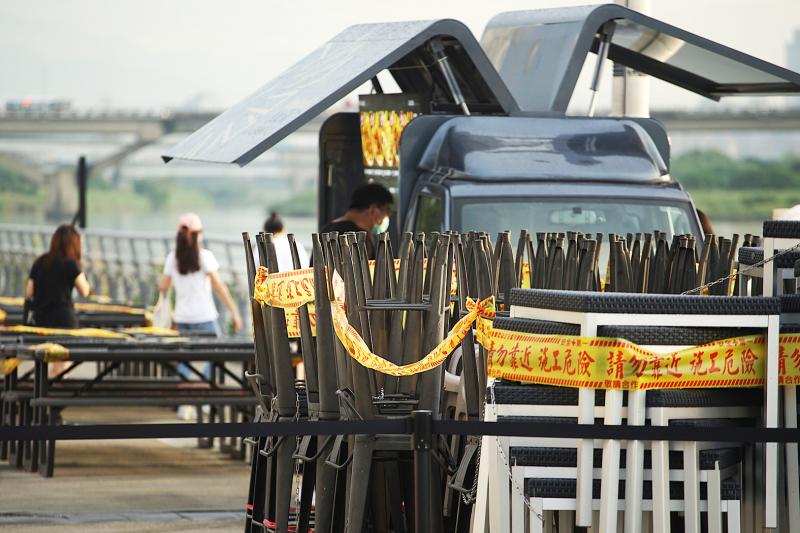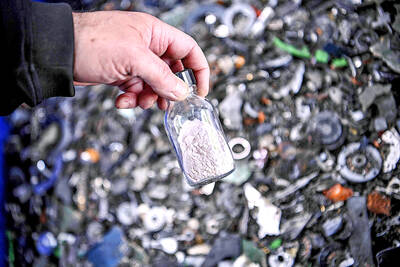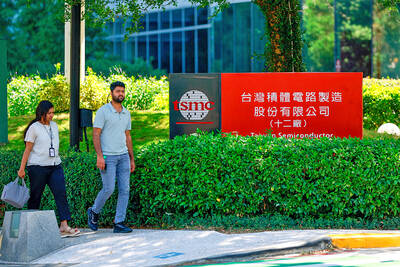Taiwan’s economy last quarter expanded 7.47 percent from a year earlier, 0.54 percentage points faster than last month’s official forecast, thanks to stronger-than-expected exports, the Directorate-General of Budget, Accounting and Statistics (DGBAS) said yesterday.
“The domestic COVID-19 outbreak wreaked havoc with service-oriented sectors, but did not affect the manufacturing industry, which continued to benefit from the stay-at-home economy and gradual reopenings in the US and Europe,” Wu Pei-shuan (吳佩璇), an official at the agency’s national income section, told an online news conference.
Exports surged 37.35 percent year-on-year from April to June on the back of robust demand for electronics used in smartphones, laptops, TVs and vehicles, as well as artificial intelligence and Internet-of-Things applications.

Photo: CNA
Outbound shipments of plastic, chemical and base metal products also spiked more than 40 percent as customers around the world rebuilt inventory, DGBAS said.
The COVID-19 pandemic has prompted schools, companies and government agencies to speed up digital transformation, thereby bolstering the selling prices of electronic components and contributing to supply crunches and shipping chaos, it said.
Imports soared 36.38 percent, driven by agricultural and industrial price hikes and avid purchases of capital equipment and consumer goods, the agency’s report showed.
Altogether, external demand contributed 5.19 percentage points to last quarter’s GDP, Wu said.
For the first half of the year, the economy grew 8.19 percent, meriting an upward revision next month, when the statistics agency updates its economic forecast. The official declined to speculate.
Domestically, private consumption shrank 0.55 percent, weighed down by a soft lockdown as the government on May 19 imposed a nationwide level 3 COVID-19 alert to curb the outbreak, the DGBAS said.
However, retail sales increased 2.29 percent year-on-year as e-commerce flourished, while physical stores and businesses were hit hard, Wu said.
Securities trading also thrived, with daily turnover growing more than twofold, she added.
Still, private consumption dragged GDP growth by 0.2 percentage points, the agency said.
The government lent support by adding 0.34 percentage points to GDP growth as it stepped up COVID-19 testing, vaccination and treatment expenses, DGBAS said.
The second quarter also saw capital formation swell 24.39 percent from a year earlier, as Taiwanese firms build up 5G infrastructure, green energy capacity, shipping vessels and semiconductor capital equipment to meet business needs, Wu said.
Overall, domestic demand made a lackluster contribution of 2.28 percentage points to GDP growth last quarter.
Wu said private consumption would fare better from this month following the conditional opening of entertainment and recreational facilities.

RECYCLE: Taiwan would aid manufacturers in refining rare earths from discarded appliances, which would fit the nation’s circular economy goals, minister Kung said Taiwan would work with the US and Japan on a proposed cooperation initiative in response to Beijing’s newly announced rare earth export curbs, Minister of Economic Affairs Kung Ming-hsin (龔明鑫) said yesterday. China last week announced new restrictions requiring companies to obtain export licenses if their products contain more than 0.1 percent of Chinese-origin rare earths by value. US Secretary of the Treasury Scott Bessent on Wednesday responded by saying that Beijing was “unreliable” in its rare earths exports, adding that the US would “neither be commanded, nor controlled” by China, several media outlets reported. Japanese Minister of Finance Katsunobu Kato yesterday also

Jensen Huang (黃仁勳), founder and CEO of US-based artificial intelligence chip designer Nvidia Corp and Taiwan Semiconductor Manufacturing Co (TSMC, 台積電) on Friday celebrated the first Nvidia Blackwell wafer produced on US soil. Huang visited TSMC’s advanced wafer fab in the US state of Arizona and joined the Taiwanese chipmaker’s executives to witness the efforts to “build the infrastructure that powers the world’s AI factories, right here in America,” Nvidia said in a statement. At the event, Huang joined Y.L. Wang (王英郎), vice president of operations at TSMC, in signing their names on the Blackwell wafer to

‘DRAMATIC AND POSITIVE’: AI growth would be better than it previously forecast and would stay robust even if the Chinese market became inaccessible for customers, it said Taiwan Semiconductor Manufacturing Co (TSMC, 台積電) yesterday raised its full-year revenue growth outlook after posting record profit for last quarter, despite growing market concern about an artificial intelligence (AI) bubble. The company said it expects revenue to expand about 35 percent year-on-year, driven mainly by faster-than-expected demand for leading-edge chips for AI applications. The world’s biggest contract chipmaker in July projected that revenue this year would expand about 30 percent in US dollar terms. The company also slightly hiked its capital expenditure for this year to US$40 billion to US$42 billion, compared with US$38 billion to US$42 billion it set previously. “AI demand actually

RARE EARTHS: The call between the US Treasury Secretary and his Chinese counterpart came as Washington sought to rally G7 partners in response to China’s export controls China and the US on Saturday agreed to conduct another round of trade negotiations in the coming week, as the world’s two biggest economies seek to avoid another damaging tit-for-tat tariff battle. Beijing last week announced sweeping controls on the critical rare earths industry, prompting US President Donald Trump to threaten 100 percent tariffs on imports from China in retaliation. Trump had also threatened to cancel his expected meeting with Chinese President Xi Jinping (習近平) in South Korea later this month on the sidelines of the APEC summit. In the latest indication of efforts to resolve their dispute, Chinese state media reported that